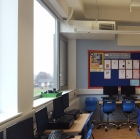Maximising natural ventilation for science and IT areas in schools

Gilberts (Blackpool) offers a solution to maximise the benefits of natural ventilation in rooms such as IT suites and science laboratories in schools. Particular issues in such areas include heat from IT equipment and CO2 from Bunsen burners. Gilberts’ solution is its Mistrale Fusion (MFS) natural-ventilation system with the inclusion of enhanced and boost options.
Standard flow rate for a classroom with 32 people in it is 320 l/s. In enhanced mode, the MFS256 can provide up to 400 l/s, while keeping noise level below 35 dB(A). The boost mode is configured for up to 550 l/s, equivalent to 13 air changes an hour, to redress to the required internal temperature and air quality.
The boost mode also accelerates night cooling, purging the used air so ambient comfort is restored more quickly.
Gilberts’ technical director Roy Jones explains, ‘Having the extra capacity as standard within our MFS units to cope with higher loads for specialist classrooms is a major advantage for specifiers, contractors and the building operator.
‘That advantage is further enhanced by the ability to fully purge at even higher air volumes, to redress the imbalance from specialist activity, and maintain the environmental and noise benefits required by DfE specification, at minimal cost,’








